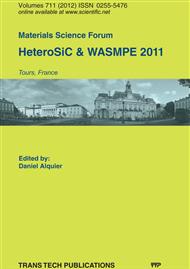p.3
p.11
p.16
p.22
p.27
p.31
p.35
p.43
CVD Growth of 3C-SiC on 4H-SiC Substrate
Abstract:
The hetero epitaxial growth of 3C-SiC on nominally on-axis 4H-SiC is reported. A horizontal hot-wall CVD reactor working at low pressure is used to perform the growth experiments in a temperature range of 1200-1500 °C with the standard chemistry using silane and propane as precursors carried by a mix of hydrogen and argon. The optimal temperature for single-domain growth is found to be about 1350 °C. The ramp up-conditions and the gas-ambient atmosphere when the temperature increases are key factors for the quality of the obtained 3C layers. The best pre-growth ambient found is carbon rich environment; however time of this pre-treatment is crucial. A too high C/Si ratio during growth led to polycrystalline material whereas for too low C/Si ratios Si cluster formation is observed on the surface. The addition of nitrogen gas is also explored.
Info:
Periodical:
Pages:
16-21
Citation:
Online since:
January 2012
Authors:
Keywords:
Price:
Сopyright:
© 2012 Trans Tech Publications Ltd. All Rights Reserved
Share:
Citation:


